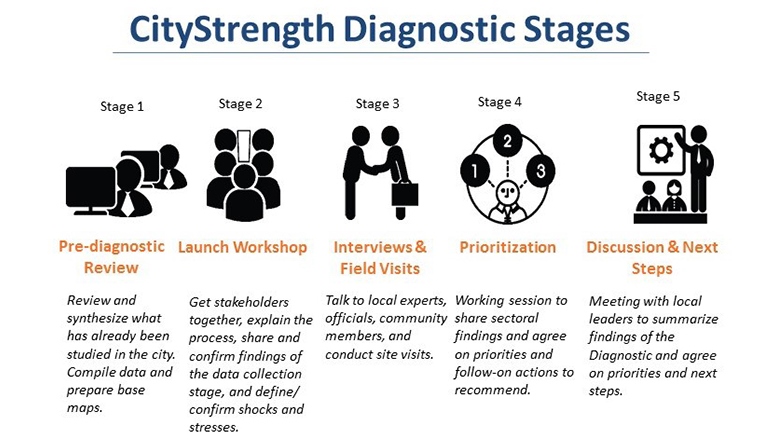With most of the global population and capital goods concentrated in urban areas, cities are key to social development and economic prosperity. They are drivers of national economic growth and innovation, and act as cultural and creative centers. But urbanization also brings challenges. With a greater concentration of people, assets and infrastructure in urban areas, an increasingly complex range of shocks and stresses can put in jeopardy human wellbeing and hard-won development gains.
Within this global context, the World Bank and the Global Facility for Disaster Reduction and Recovery (GFDRR) developed the CityStrength Diagnostic was developed to facilitate a dialogue among stakeholders (e.g. government, civil society, residents, and the private sector) about risks, resilience, and the performance of urban systems. It helps identify priority actions and investments that will enhance the city’s resilience as well as increase the resilience-building potential of planned and aspirational projects.
Because cities depend on a complex network of infrastructure, institutions, and information – the CityStrength Diagnostic first evaluates resilience on a sectoral basis and then brings together the findings to think holistically about the city’s resilience. This process leads to the identification of critical gaps or areas of weakness that should be prioritized to unlock opportunities within the city. With this in mind, the CityStrength Diagnostic is structured around sectoral modules that cover topics within the city and metropolitan area purview, including Community and Social Protection, Disaster Risk Management, Education, Energy, Environment, Health, Information and Communications Technology, Local Economy, Logistics, Municipal Finance, Solid Waste, Transport, Urban Development, and Water and Sanitation. The CityStrength Diagnostic can be used in any city regardless of size, institutional capacity, or phase of development.
Key Publications
| CityStrength Diagnostic Methodological Guidebook | Can Tho, Vietnam - Enhancing Urban Resilience | Addis Ababa, Ethiopia - Enhancing Urban Resilience |
 |
 |
 |
The CityStrength Diagnostic has been piloted in two cities – Can Tho, Vietnam and Addis Ababa, Ethiopia. Across these two pilots, several benefits have been highlighted as part of the process:
- Inclusion – CityStrength invites multiple stakeholder perspectives, including across departments and tiers of government, civil society, and the private sector.
- Learning – CityStrength encourages learning and exchange on the issue of resilience and exposes stakeholders to global best practices by facilitating engagement with sectoral specialists.
- Development Impact – CityStrength identifies investment priorities in relation to city-wide resilience-building needs, rather than looking at isolated sectoral issues. This holistic approach means that the recommendations better align to local goals and development objectives and they can be taken forward with the support of a variety of development institutions.
The CityStrength Diagnostic consists of 5 stages, book-ended by leadership commitment for resilience on the front-end and a longer-term engagement with development partners through financing or technical assistance at the back-end.


